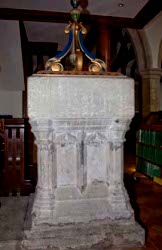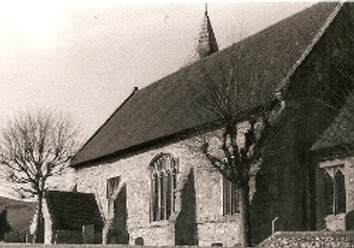Eastbourne – St Mary, Willingdon
A complex church with a broad nave that probably goes back to the late C12, though most detail is C14 and C15. Its relationship to the north aisle and the C13 north west tower is problematic. The chancel was only built about 1400. There are good C16 and C17 monuments.
The village of Willingdon is just outside the town of Eastbourne, but it is in all but name a suburb and is best considered as part of it. The church stands off the former main road approaching the town from the direction of London, whilst the area immediately around retains something of its former character, with a fine house by Lutyens opposite.
The church presents a number of problems. Because the north arcade is early C14, the broad nave and north aisle have generally been thought to be of that date (1 p3). However, the remains of a tall lancet, possibly round-headed, in the south wall suggest the nave is late C12, a more likely date for a nave with no chancel; in 1394 the eastern nave was still used as one (ibid). What appear to be the jambs of a doorway under the C15 centre south window may mark the original position of the south doorway, which has been relocated and is now within the C15 porch. It has pairs of shafts on each jamb (the bases now concealed) and two orders; the inner is keeled and the outer one and the label filleted, so it is before 1250.
An undersized tower at the west end of the north aisle has a low, shingled broach and lancets. Despite later alterations, the plain, pointed head and abaci show the arch into the aisle (now blocked) to be early C13 at the latest and thus a further survival of an earlier church. Outside, on the east side of the tower, is the outline of a higher gabled roof. Pevsner interpreted this as belonging to an earlier nave, converted into an aisle in the C14 when a larger nave was built to the south (BE p629). This is doubtful, both because it disregards the likely C12 origin of the present nave and because gabled aisles were common and what is postulated to have been the previous nave would hardly have been reduced to a lean-to aisle. Parsons and Milner-Gulland (p130) suggest that notwithstanding the relatively early date, the aisle was gabled from the first, though there must have been an arcade and its reconstruction in the C14 is hard to explain. Only archaeological investigation could clarify this, but on present evidence it does indeed appear likely that both the aisle and the nave are older than the C14.
Though its relationship with the earlier work is problematic, the C14 work itself is more straightforward. The north arcade has four bays, of which the eastern one post-dates Sir Stephen Glynne’s visit (before 1840) (SRS 101 p312) since he describes a solid wall to the nave. Behind this the aisle continued to the east end as a chapel, as the east window with pierced spandrels shows. On the basis of windows since replaced, Glynne believed that the section of aisle behind, now a family chapel, had been added in Elizabethan times but there is no reason to doubt that it belongs to the rest of the aisle. The main aisle roof is a single structure with old tiebeams and plain posts. Corbels on the aisle side for the roof of the previous gabled structure, are too plain for dating. The arcade has octagonal piers on high bases, and the nave roof has rough-cut ties and now warped crownposts braced four ways. All are C14, as are the two-light square-headed aisle-windows with ogee heads. Though renewed, the first of two Sharpe Collection drawings (undated, but c1800) shows similar ones. Adelaide Tracy (1855) (IV p46) shows segmental heads, but as she did not visit all churches in East Sussex, the Sharpe drawing is preferable as evidence.
In the early C15 the chancel was added. It is surprisingly short, especially as there was none previously and this would rule out the re-use of older foundations. The limits of the churchyard probably determined the size. The east window is C19 (its predecessor is shown blocked on the second Sharpe drawing of 1804), but the two-light square-headed side-windows are partly old and certainly C15. The broad double-chamfered chancel arch has semi-octagonal responds with characteristic C15 mouldings on the abaci. About 5ft in front of the arch are brackets for the rood and to the north the entrance to the stair has survived the insertion of the fourth arch, next to a niche of uncertain purpose.
The south side of the nave was also remodelled in the C15, but possibly later and not all at once. Three windows were inserted, each different. From the west, there is a two-light segment-headed window with panelled tracery, then a similar but four-light one and finally a two-light square-headed one. The sills are linked by a string-course. The south porch is also C15 with an old crownpost roof, which was formerly higher, as the outline on the nave wall shows.
On the west gable of the nave is an inscription dated 1650. This must refer to the walling above a rough string-course; unusually there is no window and a plain, blocked, doorway is off-centre under the outline of what may be a porch. Godfrey suggests (1 p4) it led to an attached vicarage, but here too only excavation can provide an answer. Because of differences between the Sharpe Collection drawings of c1800 and 1804, Verena Smith proposed (Sharpe Collection catalogue 353) that the tower was slightly heightened and the spire altered in the interim. That would predate the brick and flint angle-buttresses, which bear the date 1846.
Details of C19 restorations are incomplete. Within a year of the addition of the tower buttresses there was an unsuccessful application to the ICBS in 1847, seeking to re-pew the church, but this mentions only the names of the builders (Haines and Maynard). By 1875 £1042 had been spent (PP125) so later efforts were more successful and these probably included the roof and a new reticulated east window. There is greater certainty with Paley and Austin‘s restoration of the north aisle in 1878 (CDK 1878 pt 2 p74). Though not stated in their report, they probably inserted the fourth arch of the arcade at the same time. Finally in 1904, L W Ridge built north west vestries, costing £550 (CDG 127 p87). Bomb damage in World War II affected some monuments but was otherwise largely confined to the glass and in 1953 W H R Blacking added a west gallery in C17 style (BE(E) p664).
Fittings and monuments
Aumbry: (Chancel north) Plain and square. C15.
Brass: (North chapel) John Parker (d1558). He appears to be striding and has a helm behind his head. His wife is missing. This has been assigned to the workshop responsible for the Nayle style (see London workshops).
Chest: Massive C14 work, with a top opening in two parts (now displayed at Michelham priory).
Font: C15 and square, made of local greensand like others, e g St Mary, Eastbourne. The base, almost as thick as the bowl, has two ogee-headed arches on each side.
Font cover: W H R Blacking, 1953 (BE(E) ibid).
Glass:
1. (North chapel, east window) Restored heraldic glass of 1622 connected with the Parkers.
2. (Chancel north window) Burlison and Grylls, 1888 (BE(E) ibid)
3. (North chapel, north window) Burlison and Grylls, 1894 (CDG 3 p50) (David and St Cecilia).
4. (East window) C Webb, 1946, Christ in Glory (www.stainedglassrecords.org retrieved 11/2/2013).
5. (Nave, south east window) C Webb (ibid), c1946 (scenes from the life of St Paul).
6. (Nave, centre south window) War memorial window, H Easton, 1947 (DSGW 1958). At the base representatives of all three services kneel in a Downland scene.
7. (North aisle, first window – Eustace Tanner) H Easton 1948-49 (ibid).
8. (Nave, south west window) Sir J N Comper, 1948 (Symondson and Bucknall p305).
Monuments:
The north or Ratton chapel contains almost all the monuments to the Parkers, who owned the manor from the C16 to the mid-C18, and to the Freeman-Thomases who followed. The monuments are there unless stated.
1. (By altar) Elinar Parker (d1598) Small kneeling alabaster figure.
2. (North chancel) Sir John Parker (d1617). Kneeling effigy in armour. The decoration beneath includes a green man.
3. Sir Nicholas Parker (d1619) Recumbent effigy in coloured alabaster with three wives kneeling below and a tall, pillared back. Restored after bomb damage (Llewellyn p397).
4. (North aisle) Sir Thomas Parker (d1663) and family, the last of whom died in 1695. It consists of a large marble urn on a narrow base with heraldic achievements each side and Llewellyn’s suggestion (p396) that it is probably early C18 is likely; it is attributed to J Latham (BE(E) ibid).
5. (East wall) William Parker (d1727) Draped cartouche, surrounded by cherub’s heads, with an elaborate inscription in Latin, attributed to E Stanton and C Horsnaile (ibid).
6. Sir George Parker (d1726) and his wife. A large standing memorial, but purely architectural.
7. Katherine Nutt (d1700) Oval cartouche to a daughter of the Parker family, attributed to T Stayner (ibid).
8. Inigo Thomas (1847?) by H Weekes (Roscoe p1342).
9. 1st Marquess of Willingdon (d1941). A major figure in early C20 imperial history, culminating in his appointment as Viceroy of India. He was the head of the Freeman-Thomas family. Plain tablet with his banner as a Knight of St Michael and St George hanging above.
Piscina: (South chancel) Early C15 with a damaged cusped head.
Rood: Sir J N Comper, 1954. A beam within the chancel with gilded figures (ibid).
Royal Arms: (On west gallery) Dated 1953, commemorating the Coronation of Elizabeth II.
Sedile: (South chancel) Four-centred head and doubtless C15.
Sources
1. W H Godfrey: Guide to the Church of St Mary the Virgin, Willingdon, Sussex (Sussex Churches no 8), 1947
2. W H Legge: Villages and Churches of the Hundred of Willingdon, Rel 7 (1901) pp145-57
My thanks to Nick Wiseman for the colour photographs











